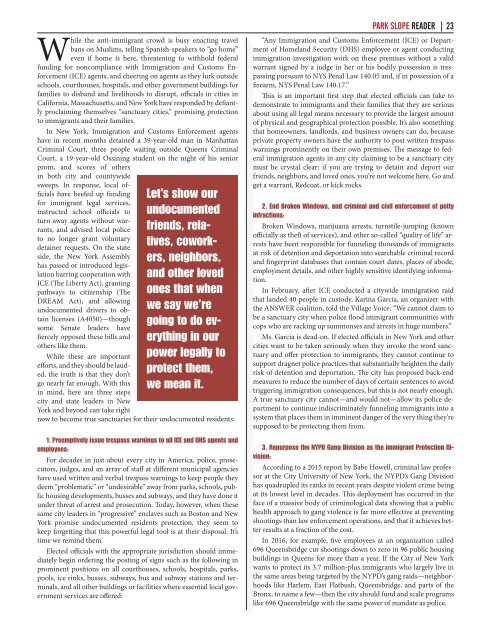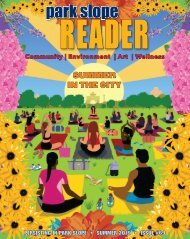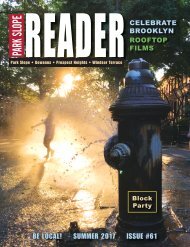PSR_61
Create successful ePaper yourself
Turn your PDF publications into a flip-book with our unique Google optimized e-Paper software.
Let’s show our<br />
undocumented<br />
friends, relatives,<br />
coworkers,<br />
neighbors,<br />
and other loved<br />
ones that when<br />
we say we’re<br />
going to do everything<br />
in our<br />
power legally to<br />
protect them,<br />
we mean it.<br />
While the anti-immigrant crowd is busy enacting travel<br />
bans on Muslims, telling Spanish-speakers to “go home”<br />
even if home is here, threatening to withhold federal<br />
funding for noncompliance with Immigration and Customs Enforcement<br />
(ICE) agents, and cheering on agents as they lurk outside<br />
schools, courthouses, hospitals, and other government buildings for<br />
families to disband and livelihoods to disrupt, officials in cities in<br />
California, Massachusetts, and New York have responded by defiantly<br />
proclaiming themselves “sanctuary cities,” promising protection<br />
to immigrants and their families.<br />
In New York, Immigration and Customs Enforcement agents<br />
have in recent months detained a 39-year-old man in Manhattan<br />
Criminal Court, three people waiting outside Queens Criminal<br />
Court, a 19-year-old Ossining student on the night of his senior<br />
prom, and scores of others<br />
in both city and countywide<br />
sweeps. In response, local officials<br />
have beefed up funding<br />
for immigrant legal services,<br />
instructed school officials to<br />
turn away agents without warrants,<br />
and advised local police<br />
to no longer grant voluntary<br />
detainer requests. On the state<br />
side, the New York Assembly<br />
has passed or introduced legislation<br />
barring cooperation with<br />
ICE (The Liberty Act), granting<br />
pathways to citizenship (The<br />
DREAM Act), and allowing<br />
undocumented drivers to obtain<br />
licenses (A4050)—though<br />
some Senate leaders have<br />
fiercely opposed these bills and<br />
others like them.<br />
While these are important<br />
efforts, and they should be lauded,<br />
the truth is that they don’t<br />
go nearly far enough. With this<br />
in mind, here are three steps<br />
city and state leaders in New<br />
York and beyond can take right<br />
now to become true sanctuaries for their undocumented residents:<br />
1. Preemptively issue trespass warnings to all ICE and DHS agents and<br />
employees:<br />
For decades in just about every city in America, police, prosecutors,<br />
judges, and an array of staff at different municipal agencies<br />
have used written and verbal trespass warnings to keep people they<br />
deem “problematic” or “undesirable” away from parks, schools, public<br />
housing developments, busses and subways, and they have done it<br />
under threat of arrest and prosecution. Today, however, when these<br />
same city leaders in “progressive” enclaves such as Boston and New<br />
York promise undocumented residents protection, they seem to<br />
keep forgetting that this powerful legal tool is at their disposal. It’s<br />
time we remind them.<br />
Elected officials with the appropriate jurisdiction should immediately<br />
begin ordering the posting of signs such as the following in<br />
prominent positions on all courthouses, schools, hospitals, parks,<br />
pools, ice rinks, busses, subways, bus and subway stations and terminals,<br />
and all other buildings or facilities where essential local government<br />
services are offered:<br />
park slope reader | 23<br />
“Any Immigration and Customs Enforcement (ICE) or Depart-<br />
ment of Homeland Security (DHS) employee or agent conducting<br />
immigration investigation work on these premises without a valid<br />
warrant signed by a judge in her or his bodily possession is trespassing<br />
pursuant to NYS Penal Law 140.05 and, if in possession of a<br />
firearm, NYS Penal Law 140.17.”<br />
This is an important first step that elected officials can take to<br />
demonstrate to immigrants and their families that they are serious<br />
about using all legal means necessary to provide the largest amount<br />
of physical and geographical protection possible. It’s also something<br />
that homeowners, landlords, and business owners can do, because<br />
private property owners have the authority to post written trespass<br />
warnings prominently on their own premises. The message to federal<br />
immigration agents in any city claiming to be a sanctuary city<br />
must be crystal clear: if you are trying to detain and deport our<br />
friends, neighbors, and loved ones, you’re not welcome here. Go and<br />
get a warrant, Redcoat, or kick rocks.<br />
2. End Broken Windows, and criminal and civil enforcement of petty<br />
infractions:<br />
Broken Windows, marijuana arrests, turnstile-jumping (known<br />
officially as theft of services), and other so-called “quality of life” arrests<br />
have been responsible for funneling thousands of immigrants<br />
at risk of detention and deportation into searchable criminal record<br />
and fingerprint databases that contain court dates, places of abode,<br />
employment details, and other highly sensitive identifying information.<br />
In February, after ICE conducted a citywide immigration raid<br />
that landed 40 people in custody, Karina Garcia, an organizer with<br />
the ANSWER coalition, told the Village Voice: “We cannot claim to<br />
be a sanctuary city when police flood immigrant communities with<br />
cops who are racking up summonses and arrests in huge numbers.”<br />
Ms. Garcia is dead-on. If elected officials in New York and other<br />
cities want to be taken seriously when they invoke the word sanctuary<br />
and offer protection to immigrants, they cannot continue to<br />
support dragnet police practices that substantially heighten the daily<br />
risk of detention and deportation. The city has proposed back-end<br />
measures to reduce the number of days of certain sentences to avoid<br />
triggering immigration consequences, but this is not nearly enough.<br />
A true sanctuary city cannot—and would not—allow its police department<br />
to continue indiscriminately funneling immigrants into a<br />
system that places them in imminent danger of the very thing they’re<br />
supposed to be protecting them from.<br />
3. Repurpose the NYPD Gang Division as the Immigrant Protection Di-<br />
vision:<br />
According to a 2015 report by Babe Howell, criminal law profes-<br />
sor at the City University of New York, the NYPD’s Gang Division<br />
has quadrupled its ranks in recent years despite violent crime being<br />
at its lowest level in decades. This deployment has occurred in the<br />
face of a massive body of criminological data showing that a public<br />
health approach to gang violence is far more effective at preventing<br />
shootings than law enforcement operations, and that it achieves better<br />
results at a fraction of the cost.<br />
In 2016, for example, five employees at an organization called<br />
696 Queensbridge cut shootings down to zero in 96 public housing<br />
buildings in Queens for more than a year. If the City of New York<br />
wants to protect its 3.7 million-plus immigrants who largely live in<br />
the same areas being targeted by the NYPD’s gang raids—neighborhoods<br />
like Harlem, East Flatbush, Queensbridge, and parts of the<br />
Bronx, to name a few—then the city should fund and scale programs<br />
like 696 Queensbridge with the same power of mandate as police.












